Plasma donation can be a great way to earn some extra income while also helping save lives. Plasma contains proteins that are used to make therapies that treat a variety of diseases and conditions.
The demand for plasma donations is high, and plasma donation centers will pay donors for their time and donation.
This article will highlight 13 of the highest-paying plasma donation centers (hopefully near you).
The compensation at these plasma centers ranges from $20 up to $150 per donation, which can make you up to $1000 for the first month with promotions.
I will outline the payout structure at each center, along with information on bonuses and referral programs.

What are The Highest Paying Plasma Donation Centers Near me?
The highest-paying plasma donation centers are given below:
Plasma Donation Centre | Pay Rate |
|---|---|
CSL Plasma | $40 to $100 per donation |
BioLife Plasma | $40 to $100 per donation |
KEDPlasma | $50 to $90 per donation |
BPL Plasma | $20 to $75 per donation |
Grifols | Reward points can be converted into gift cards or products. |
Interstate Blood Bank | $50 per donation |
Bio Test Plasma | $30 to $50 per donation |
| Vitalant | Reward points thatcan be converted into gift cards or products. |
Immunotek | $25 to $50 per donation |
American Red Cross | Unspecified |
Octapharma Plasma | $50 per donation |
GCAM Plasma | $25 to $30 per donation |
B Positive plasma | $20 to $30 per donation |
1. CSL Plasma ($40 to $100 Per Donation)
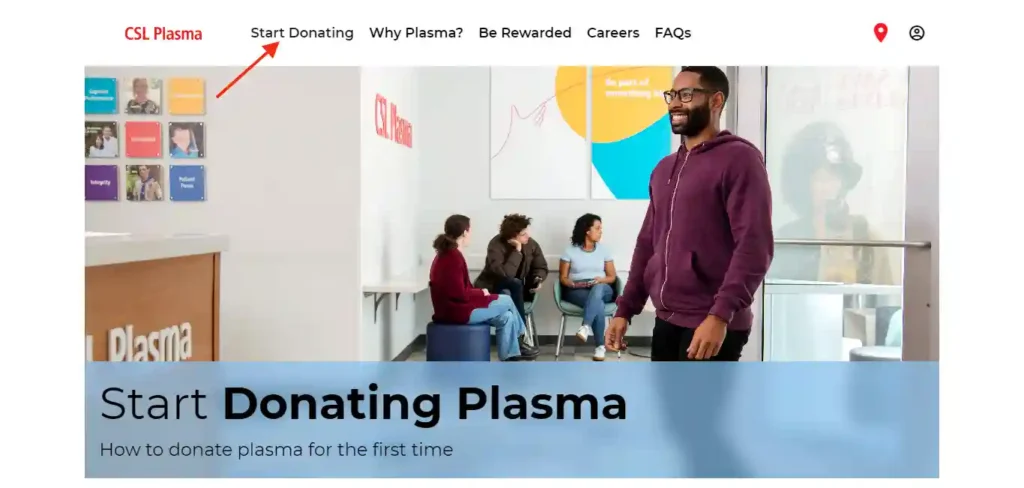
CSL Plasma is one of the most prominent and widely recognized plasma donation centers which has been in business for over 100 years.
It is available across the United States, Europe, China, and more than 300 locations.
If you’re considering donating plasma and looking for a center that offers competitive compensation, CSL Plasma should be on your radar.
How Much Does It Pay?
CSL Plasma is known for offering decent compensation to its plasma donors. If you are a first-time donor, you can make $50 to $100 per donation depending on donation centers and weight.
For returning donors, it pays $40 to $60 donation depending on your weight.
The payment structure also varies depending on factors such as location, current demand for plasma, and any ongoing promotions.
Weight (lbs) | Rate |
|---|---|
110-149 | $40-$50 |
150-174 | $45-$55 |
175-400 | $50-$60 |
Bonus rewards are also offered regularly for repeat donors. For example, CSL often provides bonuses like $150 for every 6 donations within 30 days. There are also monthly raffle prizes where donors can win up to $500.
The payment process is usually straightforward. You’ll be paid via prepaid debit cards. It means it doesn’t pay you direct cash.
What User Says About CSL Plasma?
“My first time at CSL Plasma actually went very smoothly. I signed in and before I could even sit down in the waiting room someone came to get me. They “warned” me that the process would take at least 3 hrs, to make sure that I had the time. You get a medical exam and lots of questions, but so what. It’s all necessary, and that’s only for your first time. The procedure itself varies from person to person, but can last from 1/2 hr to an hour. I, personally, didn’t have any problems. I’m glad I qualified to help and you get paid. Win-win”.- Carol W
“Well I’ve been donateing for many of years iam a veteran at it I keep comeing back cause I like the ideal that I can help save lives and the people over the years have been very polite and I’ve never had a bad donation il keep going as long as I can thank you workers of the csl plasma for making me feel at ease while I am there”.- Debra D
2. BioLife Plasma Services ($40 To $100 Per Donation)
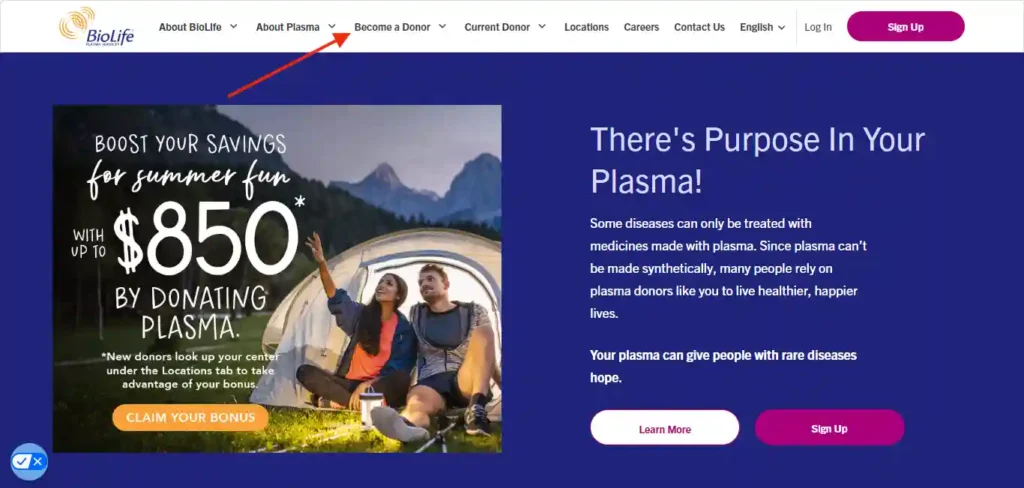
BioLife Plasma Services, a subsidiary of Takeda Pharmaceuticals, is also a prominent name in the plasma donation industry.
BioLife Plasma Services operates in 35 different states of the US and each state has several plasma donation centers.
BioLife offers flexible donation scheduling which makes it easy to plan your plasma donations. You can schedule appointments through their website or mobile app.
How Much Does It Pay?
Payment varies depending on factors such as location, promotional offers, and the number of donations made. As a first-time donor at BioLife, you can expect to earn $40 to $100 per donation.
There are also frequent bonus rewards for first-time donors. For example, you can earn up to $900 in your first month.
As a repeated donor, you can earn between $200-$300 per month depending on how often you donate.
BioLife also pays you for referring your friends or relatives. For a successful referral, you can earn $100.
The payment is provided on a reloadable BioLife MasterCard that works just like a debit card. You can use this card wherever MasterCard is accepted.
What User Says About BioLife Plasma?
I go there regularly (during promos)
Donating plasma isnt… fun. So don’t go expecting a necessarily enjoyable experience. However, I’ve been to 3 different plasma places over the years and Biolife is by far the best. All my experiences are pretty positive. The phlebs are pretty nice and are decent stickers (most of them..). They are a bit understaffed, but you’ll see a ton of staff so you don’t really feel like you’re not being helped. While some of these places definitely are sketchy, this one doesn’t really feel like that to me.
If it’s your first time, I’d advise bringing a blanket, a book/headphones for your phone/something you can do with one hand for 30-60 minutes and have a snack and some water before you go, and drink lots of water the day before. Also plan to be there for like 4 hours the first time but like maybe 1-2 at most for future visits.
Personally I’d only do it during promos. Not particularly healthy to do long term.- Sycamotree
3. KEDPlasma ($50 To $90 Per Donation)
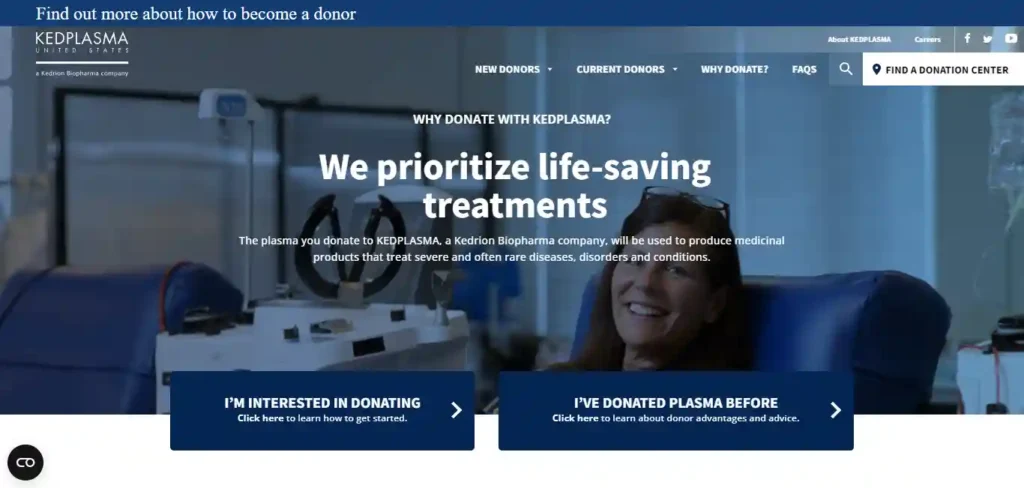
KEDPlasma is a well-established player in the plasma donation industry with over 25 centers across the United States.
While not as widespread as some of the larger plasma center networks, KEDPlasma focuses on providing excellent compensation and a comfortable donating experience.
How Much Does It Pay?
While payment rates can vary based on location and current promotions, you can generally expect a reward that reflects your time and commitment.
On average, a single plasma donation session at KEDPLASMA can earn you between $50 to $90.
It’s important to note that compensation might be higher for your first few visits as an incentive to encourage new donors.
For regular long-term donors, the monthly earnings at KEDPlasma can range from $200 to $400 on average, depending on how frequently you donate.
What User Says About KED Plasma?
“I use Ked as well in Urbana IL. Getting $50/$90 currently which includes $5 per donation for college.
$40 bonus for 8th donation of each month.
The just raised each by $10.
When I started in January of this test they were paying $60/$100 so it’d be nice to get back up to that.
It’s gotten a lot less busy since I’ve been going so maybe they’ll bump the pay.
And as the other person mentioned they have the survey system where you get 200/300 points if you complete a survey within 5 days of each donation. My center also has a wheel to spin on your second donation of each week.
Until recently it had $5/$10 bonuses for correctly answered trivia questions so I usually got at least $5 bonus per donation. However they now have gone to KED merch like tote bags and t shirts and only have like two spots for money and one spot for an express pass. Express pass allows you to jump to the front of the screening line but not bypass people already waiting to donate”.- Blackjackmark
4. BPL Plasma ($20 To $75 Per Donation)

BPL Plasma operates around 9 states of the US with multiple plasma collections in each state. These states are Arizona, Arkansas, Colorado, Florida, Kentucky, New Mexico, North Carolina, Ohio, and Texas.
Some centers even provided special bonuses for donors who referred friends or family to join the cause.
How Much Does It Pay?
As a first-time donor at BPL Plasma, you can expect to earn anywhere from $250 to $400 in your first month of donating through their new donor promotions.
The standard pay is $20 to $50 per donation depending on your weight and state.
You can get paid through reloadable debit cards that can be used at ATMs.
What User Says About BPL Plasma?
Overall BPL in Lakewood checks all the boxes. Minimal wait, cleanliness, sterile, friendly and knowledgeable staff. The only recommendation I have would be to have a more present check in station person. Every time I come I wait 3-5mins for the check in person to finish a personal conversation (which I can hear) before coming to take my name and temp.
Most importantly, I gave BPL Lakewood 5 stars because of Bianca. Im a difficult stick and she always hits my vein with no problems and no brusing afterward. She is very good at commanding the flow of the donor bay, treating people fairly, and maintaining quality standards. She is the only one I request to do my sticks. If she doesn’t have a lead position, you should consider promoting her!- Erin A.
5. Grifols (Upto $100 Per Donation)

Grifols operates over 400 plasma donation centers across the United States, Europe, Africa, and Asia under the brand names Grifols Plasma and Talecris Plasma.
Grifols centers are located in major metro areas across the US with a notable presence on the East Coast and Southeast regions.
How Much Does It Pay?
As a first-time donor at Grifols, you can expect to earn up to $1000 in your first month through their new donor compensation program including promotions.
After that, you can make around $30 for the first visit and up to $100 per donation on consecutive visits.
For regular long-term donors, the average monthly earnings at Grifols can range from $250 to $500 depending on how often you donate.
6. Interstate Blood Bank ($50 Per Donation)
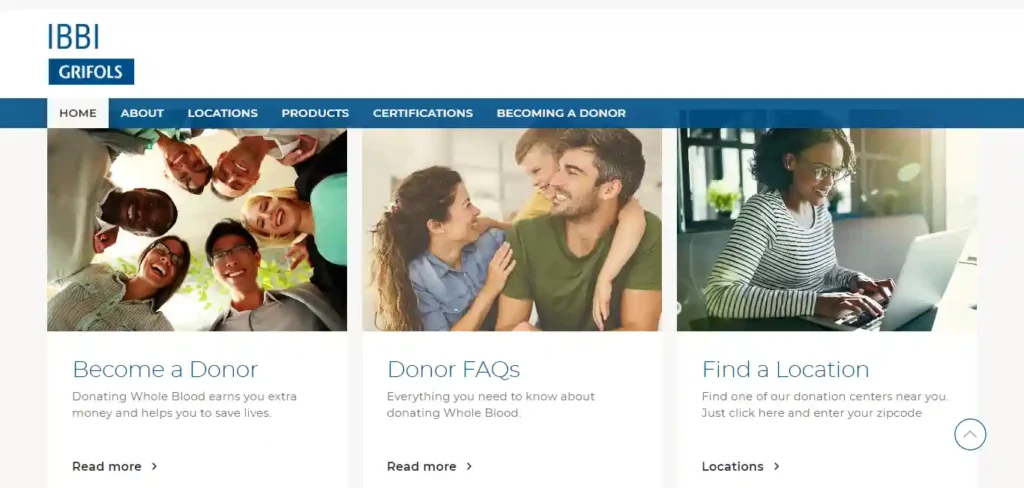
Interstate Blood Bank is one of the largest independent blood plasma collection centers in the United States.
They have a strong presence in the Eastern half, Midwest, and Southern states. If you reside in Texas, Kentucky, Indiana, or Missouri, then this plasma donation center can be easy access near you.
How Much Does It Pay?
Interstate Blood Bank offers some of the highest compensation rates for plasma donation. You can earn $50 per donation on average.
After completing your first 5 donations, you become eligible for increased compensation through their bonus rewards program.
Experienced donors who donate twice weekly can earn up to $400 per month. There are also plenty of limited-time promotions that offer extra money for referrals or donation milestones.
The exact payout depends on your weight, plasma volume, and donation frequency.
Heavier donors and those who can donate more plasma are rewarded with higher payments.
The money is loaded directly onto a prepaid debit card that is mailed to you shortly after your first donation. You can then use the card to withdraw cash or spend the money anywhere debit cards are accepted.
7. Biotest Plasma ($30 To $50 Per Donation)
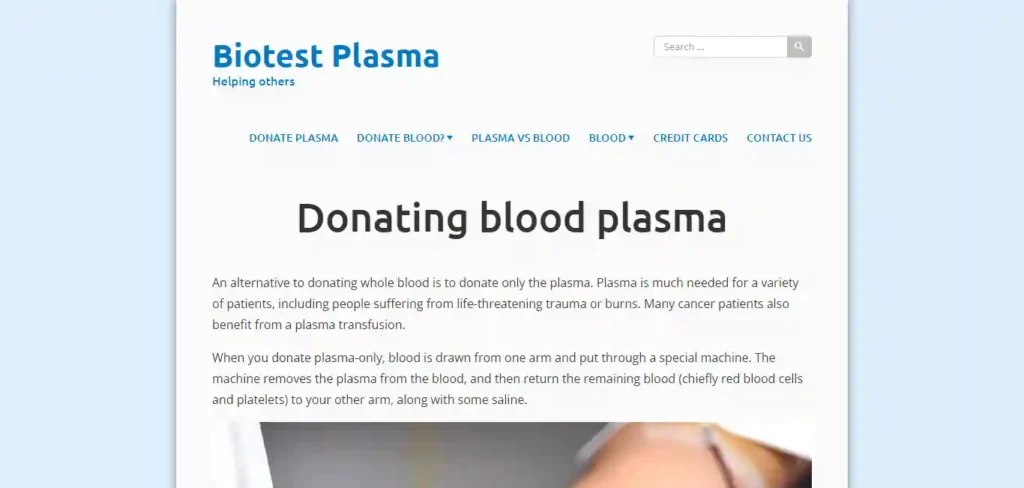
Biotest Plasma is a plasma collection center with locations across the United States. They have over 65 plasma donation centers in 23 states, making them one of the largest plasma collection networks in the country.
How Much Does It Pay?
Biotest Plasma offers competitive compensation for plasma donations. As a first-time donor, you can expect to earn $50 for your first 5 donations.
After completing the first month, the payout per donation ranges from $30 to $50 depending on your antibody levels and how often you donate.
With additional bonuses and promotions, frequent donors at Biotest can earn over $400 per month.
8. Octapharma Plasma ($50 Per Donation)

Octapharma Plasma is one of the largest plasma collection organizations in the United States with a presence in 35 states.
The company has a strong presence across the US, with centers located in major cities and metropolitan areas.
How Much Does It Pay?
Octapharma Plasma offers competitive compensation for plasma donations. You can make around $50 per donation for the first five donations.
For returning donors, compensation can increase up to $400 per month. The exact payout depends on donation frequency, weight, and target donation volumes. The more you donate, the higher your compensation.
Octapharma also offers referral bonuses, where existing donors can earn rewards for referring new donors.
The payment is often loaded onto a prepaid debit card, allowing donors to conveniently access their earnings. The card can be used like any other debit card, making it hassle-free to access your funds.
9. Vitalant

Vitalant is a non-profit organization that provides blood services across 30 states in the US.
With over 120 donation centers across the country, Vitalant is one of the largest independent blood service providers.
How Much Does It Pay?
Like other companies, Vitalent doesn’t pay you for plasma donations. Instead of money, they have a reward program where you’ll get points for donating plasma.
These points can be redeemed in the form of gift cards and electronics at the company’s prize store.
I recommend you to see the Vitalent official information for more information.
10. Immunotek ($25 To $50 Per Donation)
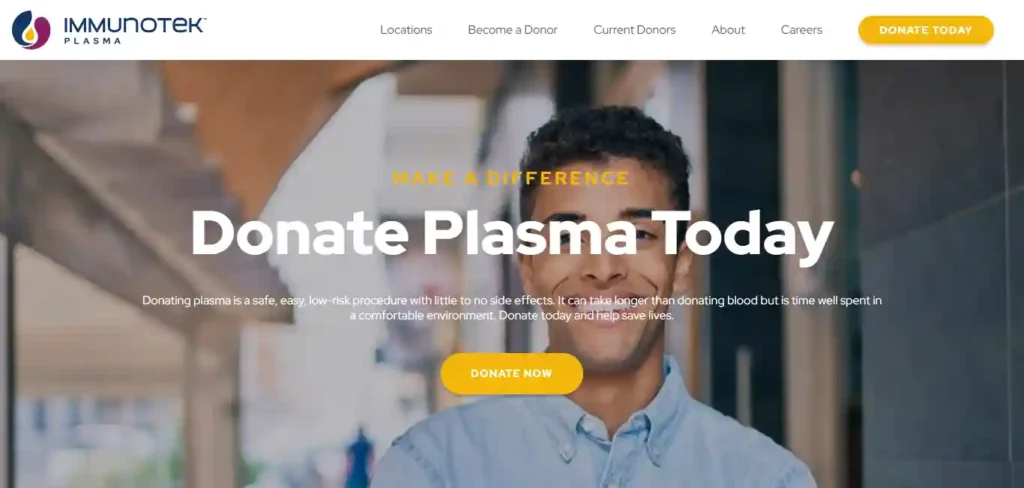
Immunotek is a plasma donation center with 11 locations across the United States. Immunotek has a strong presence in the eastern USA and Colorado.
How Much Does It Pay?
You can make between $25 to $50 depending on weight and other eligibility factors. Higher-weight donors may qualify for the maximum payout of $50 per donation.
There are also frequent promotions that can increase earning potential. By referring friends, donors can receive bonus payments.
The payment method is not mentioned on the website. So, you can get paid either in cash, check, or prepaid card.
11. American Red Cross
The American Red Cross is a nationwide non-profit organization that provides humanitarian aid, disaster relief and helps the community prepare for emergencies.
With over 500 locations across the United States, the American Red Cross has a wide presence and offers plasma donation centers at select locations. It means you can most probably find their plasma donation centers near you.
How Much Does It Pay?
The pay rate of the American Red Cross is not disclosed on its website. So, I recommend you to visit their donation centers near you to get the best pay rate.
12. GCAM Plasma ($25 To $30 Per Donation)
GCAM Plasma is headquartered in South Korea and has 13 plasma donation centers across the USA located in Texas, California, Idaho, Indiana, and Washington.
If you live near these places, you can easily donate plasma without much hassle.
How Much Does It Pay?
It pays you $25 to $30 per donation depending on location and other factors.
Additional incentives like referral bonuses and limited-time promotions can help regular donors earn even more per visit.
The payment method is not disclosed. But I am pretty sure that it pays you via cash, prepaid cards, or check.
13. B Positive Plasma ($20 To $30 Per Donation)
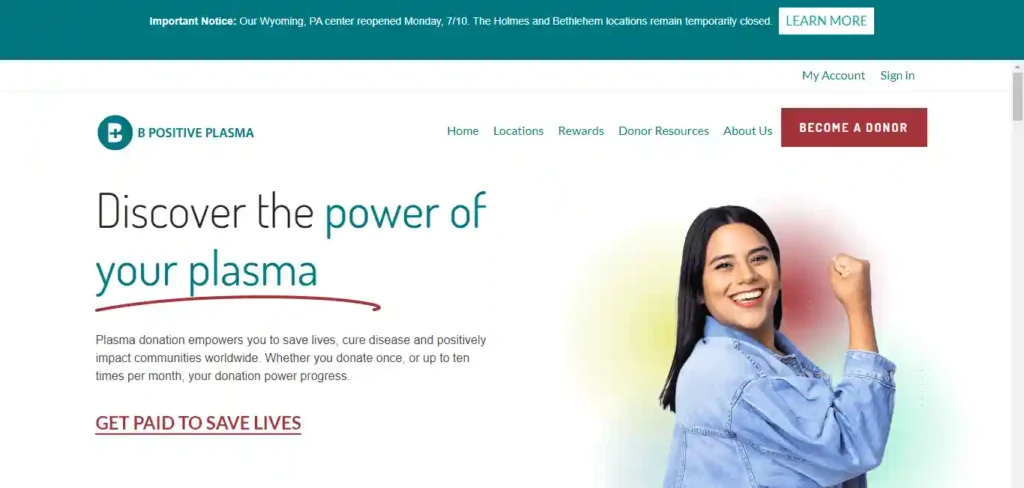
B Positive Plasma is a notable player in the realm of plasma donation centers with multiple locations in Florida, Texas, and California.
B Positive Plasma not only provides financial rewards to donors but also emphasizes the significance of their contribution.
The collected plasma is used in the creation of life-saving medications for individuals dealing with various medical conditions, including immune deficiencies, hemophilia, and more.
How Much Does It Pay?
As new donors, you can make up to $700 in the first month. Regular donors earn between $20 to $30 per visit (donation).
They also have various ongoing promotions and reward programs that can increase your earning. I recommend visiting their website to find the latest promotions.
Plasma, often called the “liquid gold” of our blood, is a vital component that keeps our bodies ticking. It’s the straw-colored, liquid part of our blood that holds red and white blood cells and platelets. It occupies 55% of our blood. But why is it so important?
What is Plasma And Why It Is Important?
Plasma is needed because it’s a rich source of essential proteins, antibodies, and other vital substances.
These components play a crucial role in clotting, fighting infections, and carrying nutrients around our bodies.
When people face medical conditions like burns, immune disorders, or bleeding disorders, plasma-derived medicines become superheroes. They’re used to create treatments like clotting factors for hemophiliacs or immunoglobulins for immune deficiencies.
People generously donate plasma to help save lives. Plasma centers use sophisticated processes to separate plasma from donated blood.
This plasma then becomes a lifeline for those relying on medical treatments. So, while it might just look like a golden liquid, plasma is a precious resource that keeps us healthy and gives hope to those in need.
Who Can Donate Plasma?
Plasma donation is a noble act that can save lives. To be a plasma donor, you need to meet certain requirements:
- Age: You need to be between 18 and 65 years old.
- Weight: Meeting a minimum weight requirement of 110 pounds is a must.
- Health: Generally, you need to be in good health to donate. No cold or flu symptoms.
- Have no tattoos or piercings in the last 4 months (some centers increase it up to 12 months).
- ID: You’ll need a valid photo ID, like a driver’s license or passport.
- Address Verification: Proof of residence is often required.
- Medical History: You’ll answer a few questions about your health and medical history.
What’s The Difference Between Donating Blood And Donating Plasma?
Donating blood and donating plasma might sound similar, but they’re different superheroes in the healthcare world.
When you donate blood, you’re giving the whole package: red cells, white cells, platelets, and plasma. It’s like donating a combo meal. But plasma donation is like focusing on the VIP part – the liquid gold.
When you donate plasma, they take out your blood, spin it around in a machine, and keep the plasma. Everything else, like those important red cells, goes back into you.
Plasma donation takes a bit more time, but it’s worth it. Plasma is like the treasure chest of proteins and antibodies, which help treat folks with immune issues and burns. Blood, on the other hand, can save lives in emergencies and surgeries.
Final Thoughts On Highest Paying Plasma Donation Centers
Plasma donation can be very lucrative if you take the time to seek out the highest-paying plasma centers in your area.
The 13 plasma donation centers highlighted in this article offer some of the most competitive compensation rates available, with per-donation payouts ranging from $20 up to $150.
The extra income from donating plasma regularly at one of these high-pay centers can quickly add up. For example, by donating plasma twice a week at a center paying $100 per donation, you could earn $800 or more in a single month.
Of course, keep in mind that plasma donation requires a time commitment and there may be physical requirements as well. Be sure to compare all the options in your area using this list as a guide, and consider taking advantage of referral bonuses and special programs.
Also read:
- Get free sign up money from these 17 sites and apps.
- Get free PayPal money with these 45 sites.
- Make an extra $1000 a month with these 31 ways.
- Make $100 fast with these 17 ways.
- 29 proven ways to make money online.
- Games that pays instantly to PayPal.


![23 Best Online Jobs For Teens [Little To No Experience]](https://sproutcent.com/wp-content/uploads/2022/12/Online-Jobs-For-teens-768x512.png)

![16 Best Places To Sell Pokemon Cards For Cash [2024]](https://sproutcent.com/wp-content/uploads/2023/01/images.jpg)
![17 Sites With Best Paying Freelancing Writing Jobs [2025]](https://sproutcent.com/wp-content/uploads/2023/03/Steps-To-Start-Website-Flipping-Business-2_result-768x512.webp)
![17 Easy & Legit Ways to Make $200 Fast in a Day [In 2025]](https://sproutcent.com/wp-content/uploads/2023/08/Make-200-Fast_result-768x502.webp)